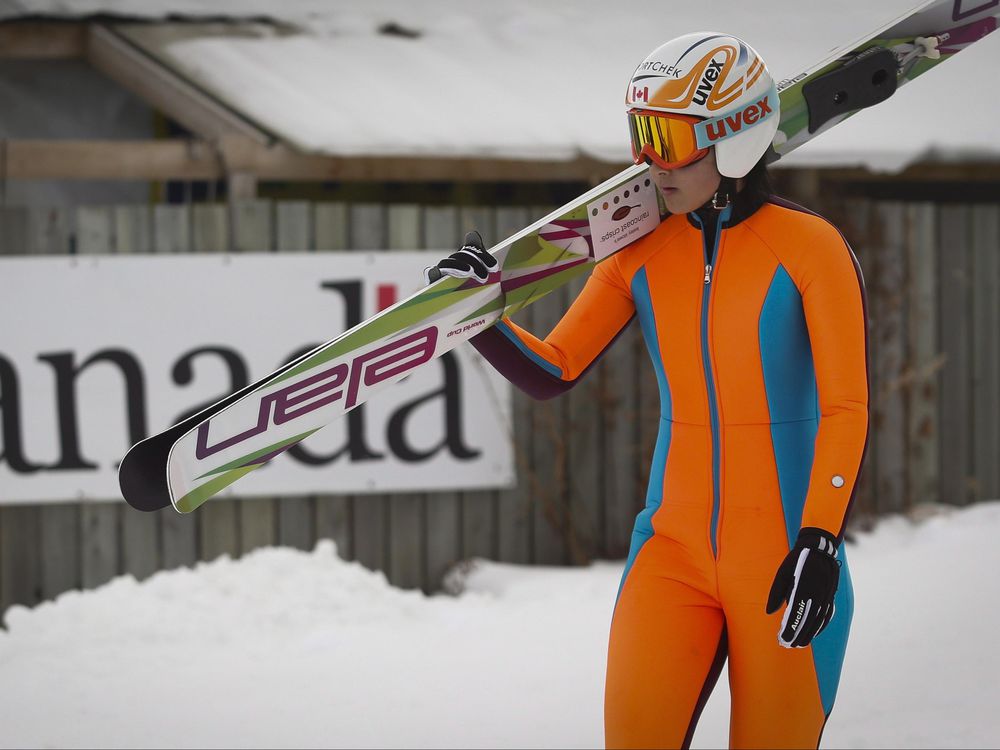Canada’s Tanaka hoping to complete comeback from injury with Olympic ski jumping berth

Canadian ski jumper Atsuko Tanaka remembers having to call her parents to pick her up from the dog park when a bout of nausea — a symptom of a concussion — brought her to her knees while she was walking her dog.
That’s when the Olympian wondered, at age 22, if her ski jumping days were behind her.
Tanaka, who finished 12th at the Sochi Games in 2014, was among a handful of athletes to make history when women’s ski jumping made its Olympic debut after years of fighting for inclusion.
But since then it’s been an uphill battle for the now 25-year-old Calgarian, who endured two anterior cruciate ligament tears in her left knee, a concussion sustained from whiplash during a car accident, and the mental pains of losing out on a full season of competition just as she was reaching her peak.
“I honestly did think about quitting a lot,” Tanaka told The Canadian Press in a recent interview. “I sunk to the level where I thought ‘this isn’t even worth it.’ I couldn’t even walk my dog.
“It was really hard to get back in the gym for a while and face everybody because they were already at peak performance and I was so behind and I didn’t think that I would be able to catch up physically and at that time mentally, too.
“I was just kind of in a hole, really stuck and couldn’t focus, and it took me a long time to get my head back in the game.”
With her sights set on qualifying for the Pyeongchang Games this February, Tanaka is hopeful that an almost two-year comeback process will pay off.
“I feel like now I’m able to find my space in my head where I can clear all my thoughts and focus,” she said. “I’ve learned to do that and I’d never been able to do that (before the injuries). So yeah, maybe I am a little stronger now.”
Currently ranked 44th in the world, Tanaka will have two months of the upcoming World Cup season, which begins Friday in Norway, to get her ranking down to 35 or better in order to qualify for Pyeongchang.
It will be Tanaka’s second full season since her injuries.
The concussion happened in November 2014 — about six month after her ACL surgery — right as she was cleared by her physiotherapist to start ramping up her workouts.
She missed the entire 2015 World Cup campaign while recovering, including the World Championships and a Grand Prix event that would have helped her qualify for the 2018 Games.
“The whole experience of injury after injury and not being able to fully come back (was tough),” Tanaka said. “I went from almost being able to ski jump to having to do everything all over again.”
Tom Reid, the chairman of Ski Jumping Canada, called Tanaka’s comeback remarkable.
“There are very few people who can take the hits that she’s taken and can get back on the horse,” Reid said. “She sustained very difficult injuries so to get back up and do it again, that speaks volumes.”
Unlike higher profile Olympic athletes, Tanaka is paying for much of her road to the Olympic Games herself — including travel, equipment, and accommodations.
She has one sponsor, Sportchek, where she also works part-time, but she’s not benefiting from Canada’s Athlete Assistance Program. Her sport is not currently funded by Own The Podium, which Reid says is “understandable.”
“It’s not supposed to be supporting the sport. Sports have to support themselves through their own fundraising, through the grassroots, through their own sponsorship,” Reid said. “Own The Podium is there to bring an athlete from ninth place to the podium, it’s not there to get someone from nothing to the podium.”
With a medal a long shot in Pyeongchang, Tanaka’s aiming instead for a spot on Canada’s Olympic team as well as a world ranking that consistently hovers around 15.
Reid believes that’s an attainable goal.
“Atsuko has shown flashes of brilliance and she’s got a gruelling two-month schedule of World Cups to qualify for South Korea,” he said.
“I think she’s got a shot. She’s not that far away from qualifying. And in ski jumping anything can happen.”





